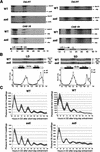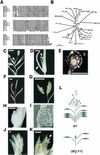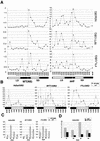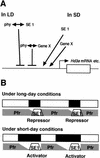Phytochrome mediates the external light signal to repress FT orthologs in photoperiodic flowering of rice
- PMID: 12154129
- PMCID: PMC186415
- DOI: 10.1101/gad.999202
Phytochrome mediates the external light signal to repress FT orthologs in photoperiodic flowering of rice
Abstract
Phytochromes confer the photoperiodic control of flowering in rice (Oryza sativa), a short-day plant. To better understand the molecular mechanisms of day-length recognition, we examined the interaction between phytochrome signals and circadian clocks in photoperiodic-flowering mutants of rice. Monitoring behaviors of circadian clocks revealed that phase setting of circadian clocks is not affected either under short-day (SD) or under long-day (LD) conditions in a phytochrome-deficient mutant that shows an early-flowering phenotype with no photoperiodic response. Non-24-hr-light/dark-cycle experiments revealed that a rice counterpart gene of Arabidopsis CONSTANS (CO), named PHOTOPERIOD SENSITIVITY 1 (Heading date 1) [SE1 (Hd1)], functions as an output of circadian clocks. In addition, the phytochrome deficiency does not affect the diurnal mRNA expression of SE1 upon floral transition. Downstream floral switch genes were further identified with rice orthologs of Arabidopsis FLOWERING LOCUS T (FT). Our RT-PCR data indicate that phytochrome signals repress mRNA expression of FT orthologs, whereas SE1 can function to promote and suppress mRNA expression of the FT orthologs under SD and LD, respectively. This SE1 transcriptional activity may be posttranscriptionally regulated and may depend on the coincidence with Pfr phytochromes. We propose a model to explain how a short-day plant recognizes the day length in photoperiodic flowering.
Figures






Similar articles
-
Phytochromes confer the photoperiodic control of flowering in rice (a short-day plant).Plant J. 2000 Jun;22(5):391-9. doi: 10.1046/j.1365-313x.2000.00753.x. Plant J. 2000. PMID: 10849355
-
Analysis of PHOTOPERIOD SENSITIVITY5 sheds light on the role of phytochromes in photoperiodic flowering in rice.Plant Physiol. 2009 Oct;151(2):681-90. doi: 10.1104/pp.109.139097. Epub 2009 Aug 12. Plant Physiol. 2009. PMID: 19675157 Free PMC article.
-
Molecular dissection of the roles of phytochrome in photoperiodic flowering in rice.Plant Physiol. 2011 Nov;157(3):1128-37. doi: 10.1104/pp.111.181792. Epub 2011 Aug 31. Plant Physiol. 2011. PMID: 21880933 Free PMC article.
-
Daylength measurements by rice plants in photoperiodic short-day flowering.Int Rev Cytol. 2007;256:191-222. doi: 10.1016/S0074-7696(07)56006-7. Int Rev Cytol. 2007. PMID: 17241908 Review.
-
Photoperiodic flowering: time measurement mechanisms in leaves.Annu Rev Plant Biol. 2015;66:441-64. doi: 10.1146/annurev-arplant-043014-115555. Epub 2014 Dec 12. Annu Rev Plant Biol. 2015. PMID: 25534513 Free PMC article. Review.
Cited by
-
Environmental Signal-Dependent Regulation of Flowering Time in Rice.Int J Mol Sci. 2020 Aug 26;21(17):6155. doi: 10.3390/ijms21176155. Int J Mol Sci. 2020. PMID: 32858992 Free PMC article. Review.
-
Pleiotropism of the photoperiod-insensitive allele of Hd1 on heading date, plant height and yield traits in rice.PLoS One. 2012;7(12):e52538. doi: 10.1371/journal.pone.0052538. Epub 2012 Dec 20. PLoS One. 2012. PMID: 23285081 Free PMC article.
-
Ectopic expression of an FT homolog from citrus confers an early flowering phenotype on trifoliate orange (Poncirus trifoliata L. Raf.).Transgenic Res. 2005 Oct;14(5):703-12. doi: 10.1007/s11248-005-6632-3. Transgenic Res. 2005. PMID: 16245161
-
A genomic and expression compendium of the expanded PEBP gene family from maize.Plant Physiol. 2008 Jan;146(1):250-64. doi: 10.1104/pp.107.109538. Epub 2007 Nov 9. Plant Physiol. 2008. PMID: 17993543 Free PMC article.
-
Biotechnological Road Map for Innovative Weed Management.Front Plant Sci. 2022 Apr 25;13:887723. doi: 10.3389/fpls.2022.887723. eCollection 2022. Front Plant Sci. 2022. PMID: 35548307 Free PMC article. Review.
References
-
- Alabadi D, Oyama T, Yanovsky MJ, Harmon FG, Mas P, Kay SA. Reciprocal regulation between TOC1 and LHY/CCA1 within the Arabidopsis circadian clock. Science. 2001;293:880–883. - PubMed
-
- Bradley D, Ratcliffe O, Vincent C, Carpenter R, Coen E. Inflorescence commitment and architecture in Arabidopsis. Science. 1997;275:80–83. - PubMed
-
- Bünning E. Circadian rhythms and the time measurement in photoperiodism. Cold Spring Harbor Symp Quant Biol. 1960;25:249–256. - PubMed
Publication types
MeSH terms
Substances
LinkOut - more resources
Full Text Sources
Other Literature Sources
Molecular Biology Databases
Research Materials
